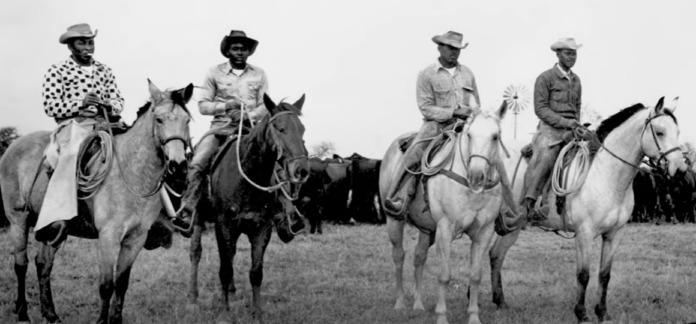During the 1870s and 1880s, African-American cowboys made up approximately 25 percent of the 35,000 cowboys in the Western frontier.
“The Federation of Black Cowboys (FBC) was created to promote knowledge of the Black West,” said Ed Dixon, FBC president.
Headquartered at Cedar Lane Stables in Howard Beach, Queens, only a white fence separates FBC from New York City streets.
Started in 1994, the Federation of Black Cowboys honors the black cowboy legacy through youth programs, rodeos, and school visits.
“Seeking to create greater understanding of African-American heritage, we provide educational opportunities for New York’s young people,” Dixon said.
“Our primary goal is to expose youth to horses and skills required to care for a horse,” Dixon said. “We use horsemanship to teach life skills such as patience, kindness, and tolerance.”
Many of the slaves in the 17th and 18th centuries were familiar with cattle herding from their homelands of West Africa. “This brings historians the question of the name ‘cowboy,’ whether it was derived from slave cow herders,” Dixon pointed out.
“Life of the black cowboy was tougher than most,” Dixon said. “It was the black cowboy who broke the horses and herded the cattle across the rivers. They took on the toughest jobs.
“Still, it was better to be a black cowboy on the ranch than a plantation slave picking cotton,” Dixon emphasized.
For the first half of the 20th century, black cowboys were not allowed to compete against white cowboys in rodeos. Nor were they allowed to work in motion pictures
“However, since most of the cowhands were black, their skills could not help but be showcased to audiences,” Dixon said.
When a rider got hurt, black cowboys were offered the opportunity to do an exhibition ride for ten dollars.
Ben “Tex” Miller, born in 1912 in South Carolina, like most African-American cowboys, did not have that kind of cash.
“But people with financial assets sponsored black cowboys whose skills they admired by paying the competition entry fees. Needless to say, Tex Miller had lots of sponsored rides,” Dixon said.
Walls of Miller’s home in Harlem are decorated with awards recognizing his accomplishments to the heritage of the African-American cowboy. Among them are a letter from New York City Mayor Bloomberg and a citation from Gene Autry.
“With the Great Depression, many Americans could no longer afford rodeo tickets, but they did go to movies,” Dixon said.
“Little to no attention was given by Hollywood to the black cowboys who made their mark in western history,” Dixon continued. Riders like Tex Miller, Bill Pickett, Nat Love and Bass Reeves were among the most famous.
Documentary filmmakers John Ferguson and Gregg MacDonald have created “The Forgotten Cowboys.” It follows the contemporary black cowboys of today while also reflecting on the black riders in the past, Dixon noted.
Life and legacy of black cowboys is still alive through the Federation of Black Cowboys. “The organization takes inner city kids off the street and teaches them life on horseback,” Dixon said.
Opportunities young people learn through the Federation of Black Cowboys gives them hope for bright futures.
“It’s something many of them may not have had in their crime-ridden and drug-infested surroundings,” Dixon reiterated. “Each child learns responsibility before being given the privilege to ride.” They must learn to completely care for the stables.
“We join with civic and community groups, in work release programs, prison visitations, parades, lectures, and block parties,” Dixon explained. The group sponsors rodeos, horse playdays and every summer hosts a prayer breakfast.
“Long-term goal for the Federation of Black Cowboys is to purchase land to build a national headquarters,” Dixon said. “It would include a museum, an indoor riding arena, as well as a library and learning center.”
CUTLINES
Ed Dixon serves as president of the Federation of Black Cowboys (FBC) which was created to promote knowledge of the African-American in the Western frontier. (FBC photo)
Ben “Tex” Miller, born in 1912 in South Carolina, was a rodeo champion in the 1930s. Walls of Miller’s home in Harlem are decorated with awards recognizing his accomplishments to the heritage of the African-American cowboy. (Federation of Black Cowboys photo)
Started in 1994, the Federation of Black Cowboys (FBC) honors the black cowboy legacy through youth programs, rodeos, and school visits. (FBC photo)
Primary goal of the Federation of Black Cowboys (FBC) is to expose youth to horses and skills required to care for a horse. (FBC photo)





